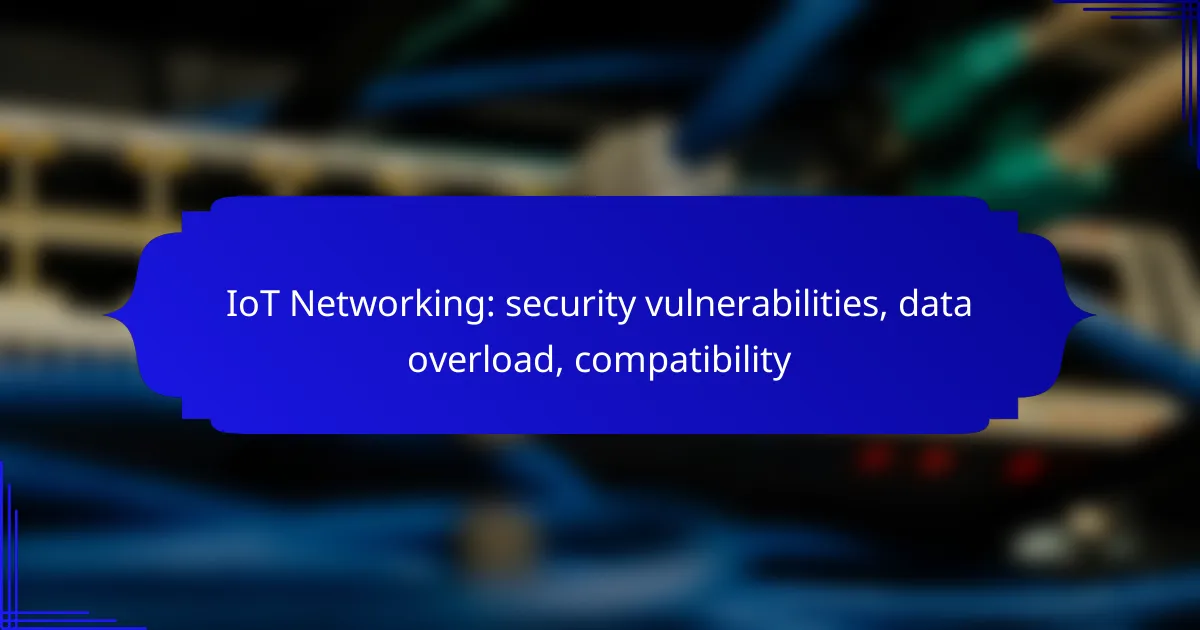The rapid expansion of IoT networking has introduced significant challenges, particularly concerning security vulnerabilities, data overload, and compatibility issues. As devices become increasingly interconnected, the risk of unauthorized access and data breaches escalates, necessitating robust security measures. Additionally, the vast amounts of data generated can overwhelm networks, leading to congestion and management difficulties. Addressing these challenges is essential for the effective deployment and operation of IoT systems.
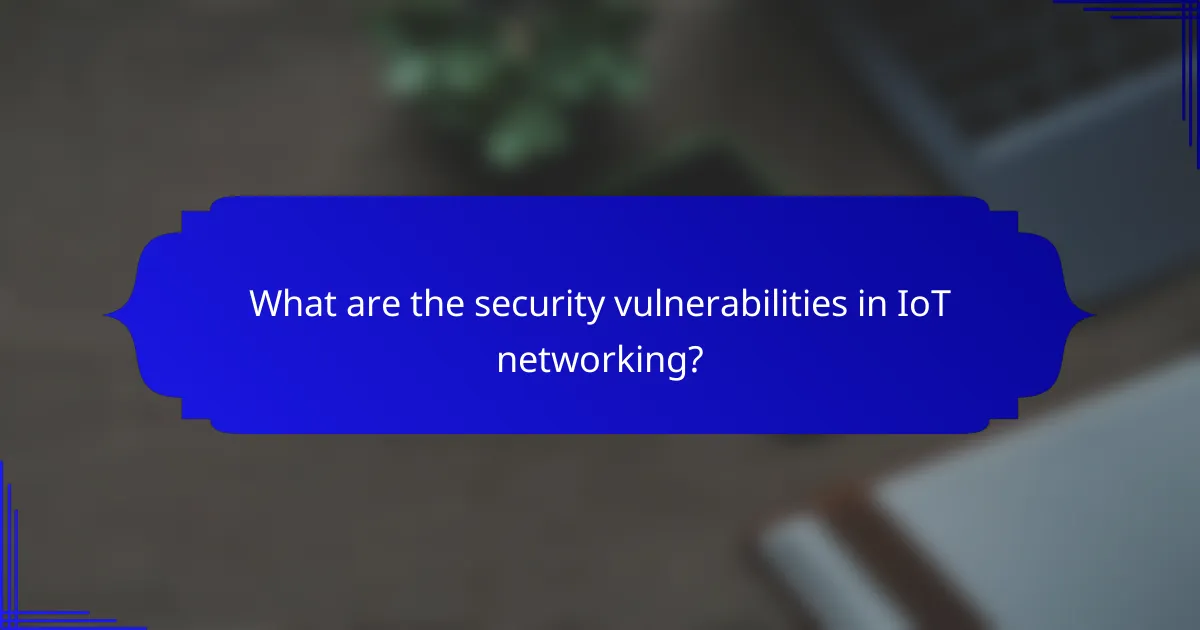
What are the security vulnerabilities in IoT networking?
Security vulnerabilities in IoT networking can expose devices and networks to various threats, including unauthorized access and data breaches. Understanding these vulnerabilities is crucial for implementing effective security measures.
Weak authentication protocols
Weak authentication protocols can allow unauthorized users to gain access to IoT devices. Many devices rely on simple username and password combinations, which can be easily guessed or cracked. Implementing stronger authentication methods, such as multi-factor authentication, can significantly enhance security.
To mitigate risks, regularly review and update authentication protocols. Ensure that devices support modern standards like OAuth or SAML, which provide more robust security compared to traditional methods.
Insecure data transmission
Insecure data transmission occurs when data is sent over networks without proper encryption, making it vulnerable to interception. This can lead to sensitive information being accessed by malicious actors. Employing encryption protocols like TLS (Transport Layer Security) is essential to protect data in transit.
Always verify that devices support secure transmission methods. Regularly update firmware to ensure the latest security patches are applied, reducing the risk of data breaches during transmission.
Device firmware vulnerabilities
Device firmware vulnerabilities arise when manufacturers fail to address security flaws in their software. These weaknesses can be exploited by attackers to gain control over devices or access sensitive data. Regularly checking for firmware updates is crucial for maintaining device security.
Establish a routine for monitoring and applying firmware updates. Consider using devices from manufacturers known for their commitment to security and timely updates, which can help mitigate these vulnerabilities.
Insufficient security updates
Insufficient security updates can leave IoT devices exposed to known vulnerabilities. Many devices may not receive regular updates, making them easy targets for cyberattacks. It’s important to choose devices that have a clear update policy and commitment from the manufacturer.
Set up alerts for firmware updates and regularly check for patches. Consider using centralized management tools that can help automate the update process across multiple devices, ensuring they remain secure.
Default credentials usage
Default credentials usage is a common vulnerability where devices are left with factory-set usernames and passwords. These credentials are often publicly available, making it easy for attackers to gain access. Changing default credentials immediately upon installation is a critical step in securing IoT devices.
Develop a checklist for device setup that includes changing default credentials and implementing strong, unique passwords. Educate users about the importance of this practice to reduce the risk of unauthorized access.
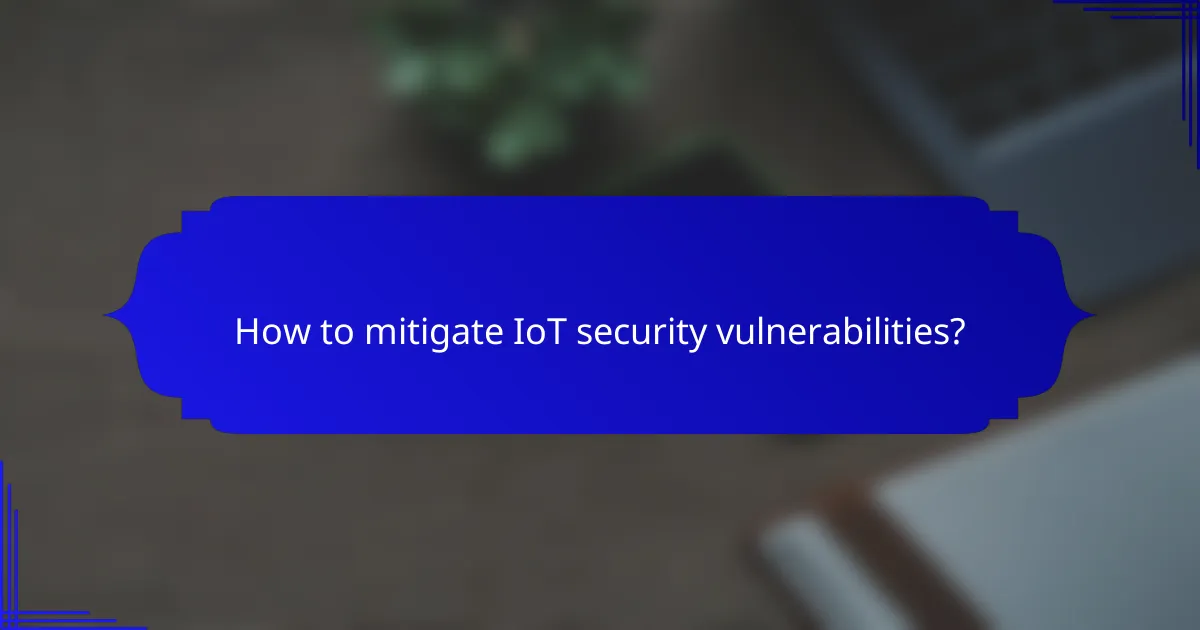
How to mitigate IoT security vulnerabilities?
To mitigate IoT security vulnerabilities, implement a multi-layered approach that includes strong encryption, regular firmware updates, multi-factor authentication, and routine security audits. These strategies collectively enhance the security posture of IoT devices and networks, reducing the risk of unauthorized access and data breaches.
Implement strong encryption
Strong encryption protects data transmitted between IoT devices and their networks, making it difficult for attackers to intercept and decipher sensitive information. Use industry-standard protocols such as AES (Advanced Encryption Standard) for data at rest and TLS (Transport Layer Security) for data in transit.
When selecting encryption methods, consider the computational power of the devices. Lightweight encryption algorithms may be necessary for devices with limited processing capabilities, ensuring security without sacrificing performance.
Regular firmware updates
Regular firmware updates are crucial for addressing known vulnerabilities in IoT devices. Manufacturers often release patches to fix security flaws, so staying current with these updates can significantly reduce the risk of exploitation.
Establish a routine schedule for checking and applying updates, and consider automating this process where possible. Be cautious of devices that do not support updates, as they may pose ongoing security risks.
Use multi-factor authentication
Multi-factor authentication (MFA) adds an extra layer of security by requiring users to provide two or more verification factors to gain access to IoT devices. This can include something they know (a password), something they have (a smartphone), or something they are (biometric data).
Implement MFA wherever possible, especially for devices that control critical systems. Educate users on the importance of MFA and ensure they understand how to use it effectively.
Conduct security audits
Conducting regular security audits helps identify vulnerabilities and assess the effectiveness of current security measures in place for IoT devices. These audits should include a review of device configurations, access controls, and compliance with security policies.
Utilize both automated tools and manual assessments to ensure comprehensive coverage. Document findings and create an action plan to address any identified weaknesses, prioritizing critical vulnerabilities that could lead to significant risks.
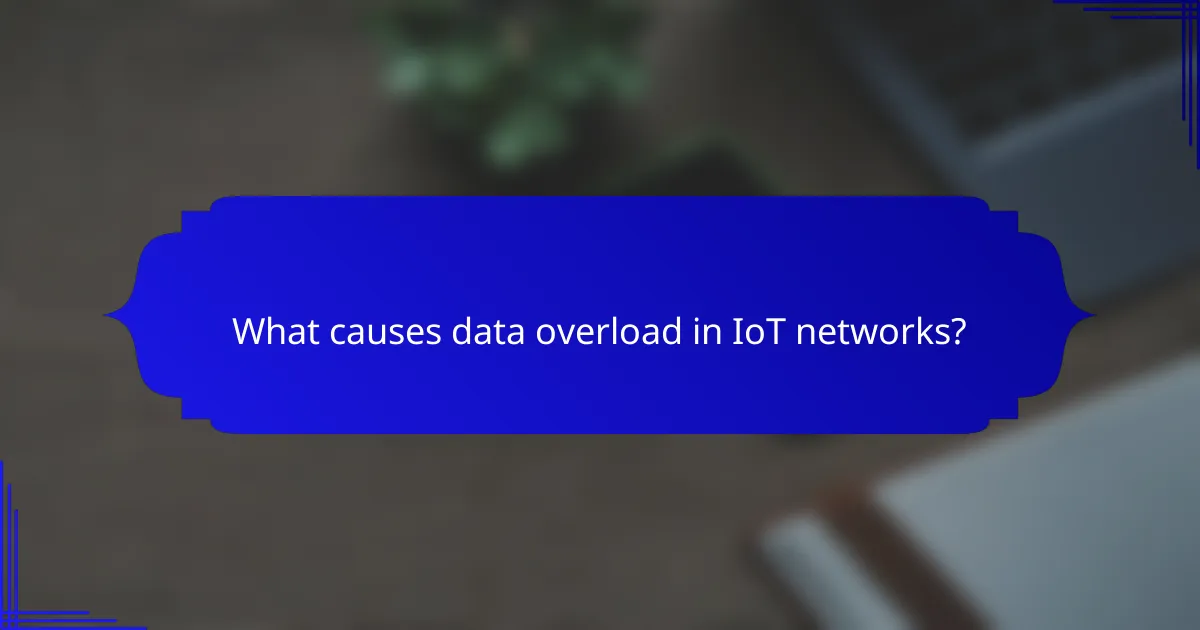
What causes data overload in IoT networks?
Data overload in IoT networks primarily results from the sheer volume of data generated by numerous connected devices. This can lead to network congestion, slow response times, and difficulties in data management.
High device density
High device density refers to the large number of IoT devices operating within a limited area, which can significantly contribute to data overload. For instance, smart homes may have dozens of devices, all transmitting data simultaneously, leading to increased network traffic.
To manage high device density, consider segmenting your network or using protocols that prioritize critical data. This can help ensure that essential communications are not lost amidst the noise of less important data transmissions.
Inadequate data filtering
Inadequate data filtering occurs when IoT systems fail to process and discard irrelevant or redundant data before it reaches the network. This can result in unnecessary data being transmitted, overwhelming the network’s capacity.
Implementing effective data filtering techniques, such as edge computing or local processing, can significantly reduce the volume of data sent to the cloud. This not only alleviates network congestion but also enhances response times for critical applications.
Continuous data streaming
Continuous data streaming involves devices that constantly send data, such as video cameras or environmental sensors. This unceasing flow can quickly saturate network bandwidth, leading to performance issues.
To mitigate the impact of continuous data streaming, consider using data compression techniques or adjusting the frequency of data transmission. For example, streaming video at lower resolutions during off-peak hours can help manage bandwidth more effectively.

How to manage data overload in IoT?
Managing data overload in IoT involves optimizing data processing and transmission to ensure efficient use of resources. This can be achieved through various strategies that reduce the volume of data sent over networks while maintaining essential information integrity.
Implement edge computing solutions
Edge computing reduces data overload by processing data closer to the source, such as IoT devices. This minimizes the amount of data transmitted to central servers, thereby decreasing latency and bandwidth usage. For instance, a smart camera can analyze video feeds locally to identify motion before sending only relevant alerts to the cloud.
When implementing edge computing, consider the capabilities of your devices and the complexity of the tasks they need to perform. Ensure that the edge devices have sufficient processing power and storage to handle the necessary computations without compromising performance.
Use data compression techniques
Data compression techniques can significantly reduce the size of data transmitted in IoT networks. By applying algorithms that minimize redundancy, you can lower bandwidth requirements and speed up data transfer. Common methods include lossless compression for critical data and lossy compression for less important information.
Evaluate the trade-offs between data quality and size when choosing compression methods. For example, using JPEG for images can save space but may reduce clarity, which is acceptable for some applications but not others. Aim for a balance that maintains the integrity of essential data while optimizing transmission efficiency.
Prioritize critical data
Prioritizing critical data is essential for managing data overload effectively. Identify which data streams are vital for operations and focus on transmitting that information first. This ensures that important alerts or metrics are delivered promptly, even during high data traffic periods.
Establish clear criteria for what constitutes critical data in your IoT ecosystem. For example, in a smart home, security alerts may take precedence over temperature readings. Implementing a tiered data transmission strategy can help manage bandwidth and ensure that essential information is always prioritized.
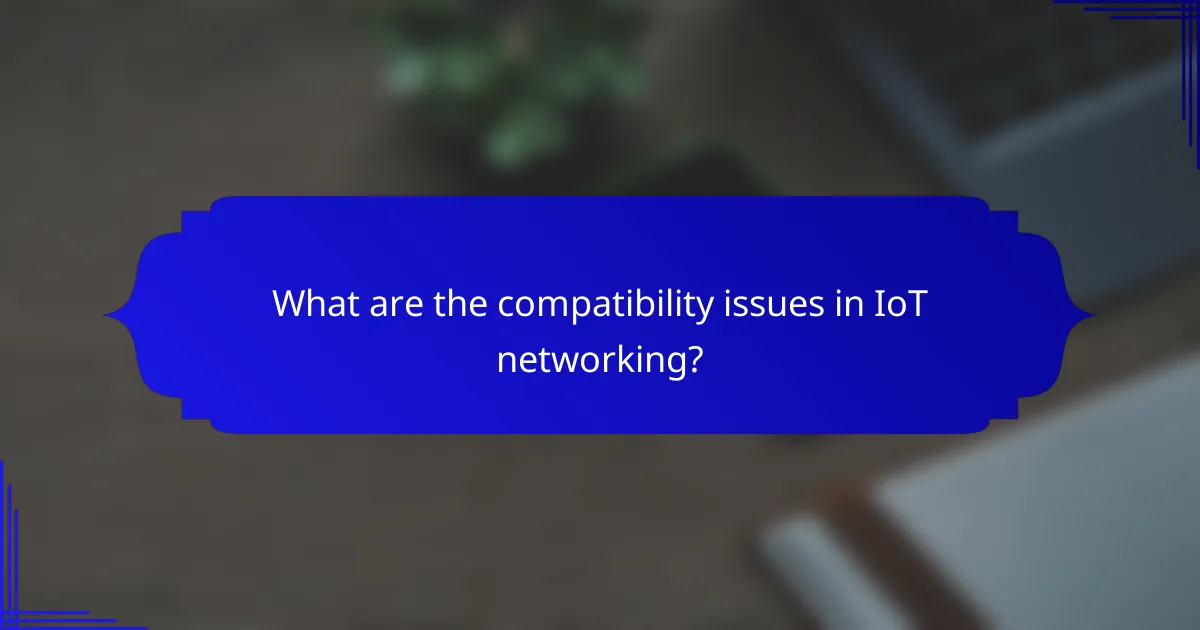
What are the compatibility issues in IoT networking?
Compatibility issues in IoT networking arise when devices from different manufacturers or with varying protocols cannot communicate effectively. This can lead to integration challenges, data silos, and reduced functionality across the network.
Device Interoperability
Device interoperability is crucial for seamless communication in IoT networks. When devices use different communication protocols, such as Zigbee, Z-Wave, or Wi-Fi, they may struggle to exchange data. This can result in limited functionality and the need for additional gateways or hubs to bridge the gaps.
To mitigate interoperability issues, consider using devices that adhere to common standards like MQTT or CoAP. This ensures better compatibility and reduces the complexity of managing multiple protocols.
Software Compatibility
Software compatibility issues can arise when IoT devices require specific firmware or software versions to operate correctly. Outdated software can lead to vulnerabilities and hinder device performance. Regular updates and patches are essential to maintain compatibility and security.
Ensure that all devices in your IoT ecosystem are running compatible software versions. Establish a routine for checking and updating firmware to prevent potential conflicts and enhance overall system reliability.
Integration with Existing Systems
Integrating IoT devices with existing systems can present challenges, particularly if legacy systems are involved. Older systems may not support modern IoT protocols, leading to data integration issues and operational inefficiencies.
When planning IoT integration, assess the compatibility of new devices with your current infrastructure. Consider using middleware solutions that can facilitate communication between legacy systems and new IoT technologies, ensuring a smoother transition.
